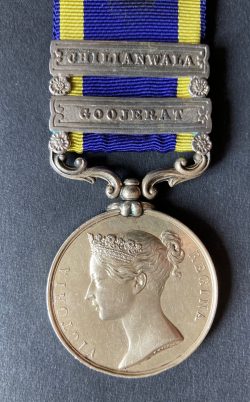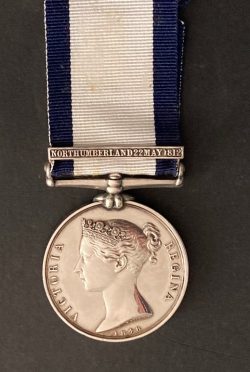The Important Second War K.B.E., C.B., Great War Royal Flying Corps Pilot’s D.S.O., M.C. as an Observer, three times M.I.D.’s, group of 14 to Air Marshal Sir Bertine Sutton, Westmorland and Cumberland Yeomanry, RFC RAF, Commanding Officer for the R.A.F. in Mohmand 1933. In the rank of Group Captain (MID) Wartime Commander of 22, 23 and 24 Groups
£11,950.00
Out of stock
K.B.E. (Military) Knight Commander’s 2nd type set of insignia, neck badge, silver-gilt and enamel; breast star, silver, silver-gilt and enamel, Order of The Bath, C.B. (Military) neck badge, silver-gilt and enamels, Distinguished Service Order, (GV.) unnamed, Military Cross, (GV) (engraved Captain B.E. Sutton, Yeo. & R.F.C. Jan. 1917),1914/15 Star (2.Lieut. West & Cumb. Yeo.) B.W.M., , (Mention in Despatches oakleaf), (Major , R.A.F.), India General Service 1908, 1 clasp, Mohmand 1933 with Mention in Despatches oakleaf (G.C., R.A.F.) Defence Medal, War Medal, with Mention in Despatches oakleaf (engraved Air Marshal, Sir Bertine E. Sutton, K.B.E. ), 1935 Jubilee, 1937 Coronation, Belgian Croix de Guerre.
Air Marshall Bertine Enwistle Sutton
(Army): – 2 Lt: 19 Oct 1914, Lt: 1 Jun 1916, (T) Capt: 6 May 1916, (T) Maj: 18 Oct 1917.
(RAF): – (T) Major [Capt]: 1 Apr 1918, Sqn Ldr: 1 Aug 1919 [1 Apr 1918], Wg Cdr:1 Jan 1924, Gp Capt: 1 Jan 1931, A/Cdre: 1 Jul 1934, AVM: 1 Jul 1937, (T) AM: 4 May 1942, AM: 1 Jan 1944.
O.B.E. London Gazette 1 January 1919. Major B.E. Sutton, D.S.O. M.C., West and Cumb. Yeo., and Royal Air Force (7 Squadron).
Original citation “This Officer has commanded his Squadron with the greatest energy and distinction since assuming Command. He has raised it to a very high standard of efficiency by his own personal efforts. This efficiency is not confined to one or two star performers, but right through the Squadron.
His knowledge of Contact and Counter Attack Patrol is exceptional from personal experience and he thoroughly understands all matters dealing with Artillery and Counter Battery work.
His administrative powers are very good and the discipline amongst Officers and men is of a high standard.
He is an exceptionally capable Squadron Commander”. Dated 30 September 1918.
K.B.E. London Gazette 11 June 1942. Air Marshal Bertine Entwisle Sutton, C.B., D.S.O., O.B.E., M.C.
Original recommendation. Air Vice Marshal B.E. Sutton, D.S.O.,.O.B.E., M.C. “Appointed as Air Officer Commanding, No. 21 Group in August 1939, and transferred to the staff of the Commander in Chief of the Home Forces in June 1940. Appointed as Air Officer Commanding, No. 24 Group, in November 1940 and posted as Commandant of the R.A.F. Staff College in November 1941.”
C.B. London Gazette 8 June 1939. Air Vice-Marshal Bertine Entwisle Sutton, D.S.O., O.B.E., M.C., Royal Air Force.
Original recommendation. Air Vice Marshal B.E. Sutton, D.S.O.,.O.B.E., M.C. “Has been Air Officer Commanding No.22 (Army Co-operation) Group since July 1936 and has done excellent work both prior to and during his tenure of this appointment.”
D.S.O. London Gazette 26 September 1917, 2nd Lt. (T./Capt.) Bertine Entwisle Sutton, M.C., Yeo. (Westmorland & Cumberland) and R.F.C.
Original citation expands
“For great gallantry, skill and continuous devotion to duty. Once on the 27th, twice on the 28th, twice on 31st. July, once on 5th, once on 8th, once on 11th, twice on 12th, twice on 14th, and twice on 15th, August 1917, he carried out extensive and valuable reconnaissances and contact patrols on the XIV Corps’ front, between LANGEMARK and BOESINGHE, at altitudes varying from 300 to 1,500 feet.
Once on 27th, once on 28th. July once on the 5th, twice on 14th and twice on 15th. August 1917 he attacked infantry and transport with his machine gun from a few hundred feet.
On 12th. August 1917 he took oblique photographs from a low altitude in a westerly direction from over the enemy’s lines, of AU BON GITE, which were valuable to the Corps in attacking it on the 14th, 15th. and 16th. August 1917.
By his energy, skill and courage, Captain Sutton has accomplished invaluable work during the recent operations and has set a magnificent example to his flight and to the Squadron.”
O’Moore Creagh D.S.O. book states for operations between Langemarck and Boisinghe July to August 1917.
M.C. London Gazette 1 January 1917 2nd Lt. (T./Capt.) Bestine (sic) Entwisle Sutton, Yeo. and R.F.C.
Original recommendation, 2/Lieutenant (Temporary Captain) Bertine Entwisle Sutton, Westmorland & Cumberland Yeomanry (T.F.) Royal Flying Corps. “For continuous hard work and untiring energy in carrying out his duties as Wing Adjutant from May to September 1916. This Officer has previously carried out most valuable work as Observer Flying Officer.”
Mentioned in Despatches
London Gazette
11 /12/1917. Lt. (T./Capt.) D.S.O., M.C. R.F.C. and Spec. Res., Yeo.
20/05/1918. R.A.F. Lt. (T./Maj.) D.S.O., M.C. Yeo.
31/12/1918. Maj. , D.S.O., M.C. (Westmorland and Cumb. Yeo. (T.F.)), 7th. Squadron, R.A.F.
Original citation. “This Officer has shown capability and energy in the handling of his Squadron during the move up to the Rhine. I attribute the good condition in which the machines and transport of this Squadron were kept, was largely due to this Officer.”
3/07/1934 “…..for distinguished services rendered in connection with the military operations against the Upper Mohmands, period 28 July to 3 October 1933.”
Group Captain (now Air Commodore) B.E. Sutton, D.S.O., O.B.E., M.C. No. 1 (Indian) Group.
Sutton was the Commanding Officer for the R.A.F. in Mohmand 1933. Only 61 clasps
Belgian Croix de Guerre
L.G. 15/07/1919. Major (A/Lt. Col.) D.S.O.,O.B.E., M.C., 7th. Sqd. (West and Cumb’ld Yeo.)
Original recommendation. “This Officer has done exceptionally well during recent operations. In spite of heavy casualties he has maintained an unfailing spirit of cheerfulness in his Squadron, and by his own personality has inspired all ranks to do their utmost under all conditions, however unfavourable.
The excellent results that have been obtained by his Squadron in Contact and Counter Attack Patrol work, and also Artillery work speak for themselves.”
Bertine Enwistle Sutton was born in Kensington, the son of the Reverend Alfred Sutton and his wife Bertha Frances Entwisle, and grandson of James Sutton of Shardlow. He was educated at Eton and University College, Oxford from where he gained his Bachelor of Arts in 1908..
After graduation, Sutton worked in a solicitor’s office in London until he was employed by Hutchinson the publishing company. Sutton had aimed to become a lawyer but the outbreak of the First World War resulted in him entering the Army.
Sutton had been an original members of the Oxford University mounted infantry and in 1914 when he joined the Inns of Court Officers’ Training Corps as a private. By October of that year, Sutton had been commissioned as a second lieutenant in the Westmorland and Cumberland Yeomanry and was sent to France.In early 1916, Sutton was posted to No. 5 Squadron of the Royal Flying Corps, where he served as an observer flying officer. Later that year, Sutton was appointed an RFC wing adjutant and underwent flying training some time in the middle part of 1916.
In 1917, Sutton first served as a pilot and then flight commander on No. 9 Squadron flying RE8s on the Western Front. In October 1917, Sutton was promoted (temporarily) to the rank of Major (t), and appointed Officer Commanding No. 7 Squadron, a position he held for the remained of the War.
Sutton was transferred to the Royal Air Force on its establishment and subsequently relinquished his commission in Westmorland and Cumberland Territorial Force.
In 1932 Sutton posted to India as the Officer Commanding No. 1 (Indian) Group and commanded the RAF unit during the Mohmand campaign in 1933 (MID and one of only 61 clasps) In late 1934 Sutton took up the appointment of senior air staff office at the headquarters of RAF India.
With the pre-Second World War build up of the RAF, Sutton was recalled to Great Britain and served as Air Officer Commanding (AOC) No. 2 (Bomber) Group, the AOC No. 22 Group and then the AOC No. 21 (Training) Group.[
At the start of the Second World War, Sutton was AOC No. 21 (Training) Group. In November 1940, Sutton continued in his training role when he was appointed AOC No. 24 (Training) Group.[2] The next year Sutton returned to staff college work, this time as the Commandant of the RAF Staff College at Bulstrode Park.
Retirement
Sutton retired from the RAF on 7 June 1945, just prior to the end of World War II. Sutton made Little Park Farm at Crookham Common, which is near Newbury in Berkshire. However, by this time Sutton was not in good health and he died just over a year later on 28 September 1946.
















